To browse through an artist's work inside the confines of an art gallery can be a cathartic and a meaningful experience or simply confounding and painful, depending on one's interest in art and the patience to try and demystify it. But to have the opportunity to actually visit an artist's studio, see him live at work and to go down his train of thought and understand why he did what he did, is indeed a very rewarding experience.
As part of a motley group of 30 art enthusiasts, I visited Jitish Kallat, the globe-trotting contemporary artist who's credited with putting India onto the global art scene through poignant works across a variety of mediums, at his studio, his most private space in suburban Mumbai. His works were scattered all over the place—some complete and ready to be dispatched, some unfinished, some deleted and re-created, while others simply relegated to history, until he would return to them at some point in the future. The humongous three-storey work space, the size which can easily accommodate a mini shopping mall, was teeming with crates upon crates of his works, some of which would find takers at galleries and shows across the world, even as the others returned back home.
Huge acrylic boards with canvases and rough sketches stood against the walls, tall and neatly clipped, with scribbles and drawings that were a prelude to the final design. "I'm at home here," says Kallat, in a black tee, checkered pants and loafers as he welcomes us, with a smile so typical of him, and takes us through his space, which seems nothing less than his personal art museum.
In a sense, the visit was very timely, as barely a week before, I had the chance to see his works on display at the Bhau Daji Lad gallery in Mumbai, in an exhibition titled, 'Asymmetrical objects.' The show was put up as a way of celebrating the Museum's 10th anniversary since its reopening to the public after restoration and 160 years after it was first opened to the public in 1857.
At the exhibition, I was particularly struck by one of Jitish's giant sculptures—a truck made out of the carcass or the decomposed vertebrae of a prehistoric creature, evoking a sense of death and mortality. It was part of his 'Animal Bone Vehicle series,' titled, 'aquasaurus', and had a motorbike and a rickshaw, too, sculpted in a similar fashion, using resin, paint and steel.
I found it gruesome and distasteful at first, but it soon fell in context when Jitish said, that it was an attempt to portray the disturbing way in which vehicles were incarcerated and torched with abandon, during the 2002 Gujarat riots.
This is what drives him and his art—the desire to pick on whatever is wrong with the society or to play on the dynamics of the good and the bad. His art mirrors the reality and in turn is affected by it, he says. The Public Notice Trilogy, a very famous and celebrated three part installation series (2003-2010) is a fine example.
The first Public Notice is statement Kallat made against the riots of 2002, by showing burnt letters of of Nehru's iconic speech, 'India's tryst with destiny,' through five acrylic mirrors. Public Notice 2, titled 'Of Bones and Salt,' is a turmeric-coloured installation of Gandhi's speech on civil disobedience. And Public Notice 3 was an installation instituted at the Art Institute of Chicago, based on the timing of the terrorist attacks at the World Trade Centre, New York that had taken place in the same month as Swami Vivekananda's speech of brotherhood at the First World Parliament of Religions.
The timing of the visit meant that we were privy to many variations of Jitish's Wind Studies (The hour of the day of the month of the season), which, he said, was to take off for Paris in the next fortnight. He applied an inflammable liquid over graphite lines on the canvas and lit it with a matchstick while on the paper so that the blowing wind would direct the course of the flame and gave shape to the charred canvas on life-size acrylic boards.
We were all left stunned. It was mesmerising to see him do and talk about such intricate and detailed work with a very casual air, as if it just came to him naturally. When someone asked him, " How do you think of such stuff and how does it come to you?" he says, "the answer to the question, I'm afraid will raise further questions and it is better to let the questions remain and hang around us, than be answered," he says with a smile.
Jitish Kallat's most famous works include Sightings, 365 Lives, Here After Here, among others.


